-
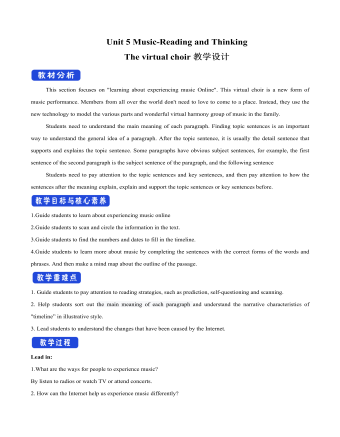
新人教版高中英语必修2Unit 5 Music-Reading and Thinking教案一
This section focuses on "learning about experiencing music Online". This virtual choir is a new form of music performance. Members from all over the world don't need to love to come to a place. Instead, they use the new technology to model the various parts and wonderful virtual harmony group of music in the family. Students need to understand the main meaning of each paragraph. Finding topic sentences is an important way to understand the general idea of a paragraph. After the topic sentence, it is usually the detail sentence that supports and explains the topic sentence. Some paragraphs have obvious subject sentences, for example, the first sentence of the second paragraph is the subject sentence of the paragraph, and the following sentenceStudents need to pay attention to the topic sentences and key sentences, and then pay attention to how the sentences after the meaning explain, explain and support the topic sentences or key sentences before.1.Guide students to learn about experiencing music online2.Guide students to scan and circle the information in the text.3.Guide students to find the numbers and dates to fill in the timeline.4.Guide students to learn more about music by completing the sentences with the correct forms of the words and phrases. And then make a mind map about the outline of the passage.1. Guide students to pay attention to reading strategies, such as prediction, self-questioning and scanning.2. Help students sort out the main meaning of each paragraph and understand the narrative characteristics of "timeline” in illustrative style.3. Lead students to understand the changes that have been caused by the Internet.

新人教版高中英语必修2Unit 5 Music-Reading For Writing教案一
(4)Now we have heard a number of outstanding speeches ... 我们已经聆听了许多精彩的发言……(5)Because we wanted the nations of the world, working together, to deal with ... 因为我们希望全世界各国团结起来去应对……(6)And if we do not act ... 如果我们不采取行动……(7)Now, I share the concerns that have been expressed ... 我也同意对于……表达的担心(8)Let us show the world that by working together we can ... 让我们告诉全世界,通过一起努力我们可以……(9)It is now time for us to ... 是时候我们……(10)And I have always wished that ... 我一直希望……(11)Thank you for letting me share this day with me.感谢你们和我共度这一天。实践演练:假如你是高中生李华,你校将举办一次以“音乐”为主题的演讲比赛,请你按照主题,写下你的演讲稿。注意:词数100左右。First of all, thank you for listening to my speech. My topic is: love music like love yourself.Music is like the air we need to maintain our normal lives around us. You can't imagine how terrible a world without music would be. Movies and TV shows have no music, only dry conversations and scenes; mobile phones only vibrations; streets only noisy crowds; cafes, western restaurants only depressed meals. What a terrible world it is!As a student, I hope we all can enjoy the fun brought by music in our spare time. Instead of just listening to music, we can even make our own music. Let's enjoy the fun of music!Thanks again for your attention!

人教版高中语文必修2《我有一个梦想》教案2篇
全班齐读第五段内容。请一位同学分析,接着让这位同学按他分析的读一遍。3、4两自然段的平缓之后,第5段作者的情感再次抬升。为了满足这种情感的张扬,作一口气连用了四个排比句式“现在是……时候”,一方面这是情感发泄的需要,另一方面这种排山倒海的语势也加强了内容的表达,极强地突出了现实为自由、平等而战的重要性。四、学会演讲我们刚才细读了课文,但读和讲是有区别的。所谓演讲,是一门语言艺术,它的主要形式是“讲”,即运用有声语言并追求言辞的表现力和声音的感染力;同时还要辅之以“演”,即运用面部表情、手势动作、身体姿态乃至一切可以理解的态势语言,使讲话“艺术化”起来,从而产生一种非凡的艺术魅力。那么,接下来就假设一下假如你是马丁·路德·金,你会怎样去讲这篇演讲辞。

新人教版高中英语必修2Unit 2 Wildlife Protection-Reading and Thinking教案一
The listening and speaking part aims at how to protect and help endangered animals by listening, speaking and talking about the facts and reasons. This lesson analyzes the decreasing clause of Tibetan antelope population and the measures of protecting Tibetan antelopes. So students can be guided to learn to analyse the title and use different reading skills or strategies, like scanning, skimming and careful reading.1. Read quickly to get the main ideas and the purpose of going to Tibetan; read carefully to understand what the author see and think.2. Understand the sentences of the present continuous passive voice such as “Much is being done to protect wildlife.” and the inverted sentence “Only when we learn to exist in harmony with nature can we stop being a threat to wildlife and to our planet.”3. Enhance the awareness of protecting wildlife.4. Cultivate the reading methods according to different materials.1. Read quickly to get the main ideas and the purpose of going to Tibetan; read carefully to understand what the author see and think.2. Understand the sentences of the present continuous passive voice such as “Much is being done to protect wildlife.” and the inverted sentence “Only when we learn to exist in harmony with nature can we stop being a threat to wildlife and to our planet.”3. Cultivate the reading methods according to different materials.Step 1 Leading-inWatch a video about elephants and whales and then ask:Why are they endangered ? They are killed/hunted

新人教版高中英语必修2Unit 2 Wildlife Protection-Reading For Writing教案一
1. 标题首先根据海报的特点、格式写明标题。海报中往往把内容作为大标题。例如: Save the earth, Save the birds。2. 正文部分不同的海报其正文部分的侧重点不同。对于介绍性的海报, 首先要引出话题, 其次列出原因, 最后是总结。对于宣传类的海报, 要写明具体内容, 如: 活动内容, 地点以及参加活动的注意事项, 主持或举办单位等。1. 图片: 要选择引人注目的图片, 与主题要相关, 色彩明亮。话题句式 1. It is a treasure of our country. 它是我国的国宝。2. Believe it or not, at present only several thousand pandas exist in the world. 信不信由你, 目前世界上仅现存几千只熊猫。 3.It’s because of human activities that tigers are endangered. 正是因为人类的活动, 老虎处于濒危的状态。4. Many wild animals are in danger of dying out. 很多野生动物面临着灭绝的危险。 5. The government has taken effective measures to protect them. 政府已采取有效的措施来保护它们。6. People should raise the awareness of the protection of wild animals. 人们应该提高保护野生动物的意识。 7. It’s amazing that there are merely less than 1, 000 finless porpoises living in China. 非常令人吃惊, 目前中国仅有不足1 000只江豚。

新人教版高中英语必修2Unit 3 The Internet-Listening &Speaking&Talking教案一
Listening and Speaking introduces the topic of “ask about online habits”. Many middle school students have been surfing the Internet for many years, but what they do with the Internet and how much time they spend every day may not be very clear to themselves, nor to other students. This section allows students to investigate their peers' Internet use, which is conducive to their mutual understanding and understanding of the Internet. It can also help them reflect on their own online behavior, learn from other people's good online habits, and get rid of their bad online behavior.The listening text of this section is an investigation interview. The investigators interview specific groups with the same questions to obtain information, so as to understand their views, practices or attitudes on this issue. There are two specific questions: “how much time do you spend online every day? What do you usually do online?”. The answers of the three respondents provide rich and different information, and achieve the purpose of the investigators. The oral discourse structure of survey interviews generally includes greeting and explaining the purpose of the interview, presenting the interview questions and the respondents' answers. Listening and Talking introduces the theme of “choosing the right application ". Listening text is a conversation between Laura and Xiao Bo. In this part of listening, “oink”; “piggy bank” may cause the students' hearing comprehension limitation. Oink refers to sound word and pig's sound. So, add some oink to my piggy bank is often used to describe "making a little money".1. Guide students to understand the content of listening texts in terms of listening for definitions.2. Cultivate students' ability to define words and understand an investigation interview.

新人教版高中英语必修2Unit 3 The Internet-Reading and Thinking教案一
Paragraph 3. Jan decided to start an IT club to teach old people how to use computers and the Internet. Paragraph 4. Jan has started taking online classes to learn more about how to use the Internet to make society better. Paragraph 5. Jan’s life has been greatly improved by the Internet. Step 5: Critical thinking:(1)How do you arrange your time spent on study and the Internet? Is it reasonable? I usually surf the Internet using my mobile phone for only an hour after class, and it is reasonable for me.(2)What are your online activities? Are they safe? I chat with my friends, read news and play games. I never give away my private information so I think they are safe.Step 4: summary Much has been written about the wonders of the World Wide Web. There are countless articles (1)______(tell) us how the Internet has made our lives more convenient. But the Internet has done a lot (2)_____(much) for people than simply make life more convenient. People’s lives (3) _________________(change) by online communities and social networks so far. Take Jan for example, who developed a serious illness that made her (4)_____(stick) at home with only her computer to keep (5)___(she) company. She joined an online group (6)______ she could share problems, support and advice with others. She considered the ability to remove the distance between people as one of the greatest (7)_______(benefit). She was so inspired (8)____ she started an IT club in which many people have been helped. She has started to learn more about how to use the Internet to make society better. Her next goal is to start a charity website to raise money (9)___ children in poor countries. Jan’s life has been (10)______(great) improved by the Internet. Step 5 Homework:Review what we have learned and find out the key language points in the text.

新人教版高中英语必修2Unit 4 History and Traditions-Listening&Speaking&Talking教案一
This unit is about history and traditions. From the opening page, we can know that this unit will introduce the history and traditions around the world. As Marcus Garvey says “A people without the knowledge of their past history, origin and culture is like a tree without roots”, it is important for students to realize the importance and value of knowing the history and traditions and their further meanings. And this part ( listening and speaking ) is divided into two parts: Part A---share views on historic sites, Part B ---talk about a visit to a historic tourist destination. By talking with a foreigner, the speakers introduce the historic attractions and their cultures. Part A is that William, a British student, who was going to visit the Confucius Temple and a Chinese student, Xiao Kong, who was going to the Confucius Temple to meet with the members of the research group, went together and exchanged their views on the Confucius Temple, Confucius, Confucius' descendants and Confucius' educational thoughts. Part B is a conversation between Xiao Yan, a youth hostel receptionist and Paul, a backpacker about the feelings and experience after visiting the Chinese famous tourist attraction Pingyao.1. Guide students to understand the content of listening texts in terms of the whole and key details; 2. Cultivate students' ability to guess the meaning of words in listening; discuss with their peers how to talk about historic spots and great person.3. Instruct students to use functional sentences of showing one’s excitement, surprise and disappointment.1. Guide students to understand the content of listening texts in terms of the whole and key details; 2. Cultivate students' ability to discuss with their peers the related topics.3. Enable students to use the functional items of showing one’s excitement, surprise and disappointment.

新人教版高中英语必修2Unit 4 History and Traditions-Reading and Thinking教案一
Features of languages1.Finally, in the 20th century, the southern part of Ireland broke away from the UK, which resulted in the full name we have today: the United Kingdom of Great Britain and Northern Ireland.该句是一个复合句。该句主句为:the southern part of Ireland broke away from the UK;which resulted in the full name we have today为which引导的定语从句代指前面整句话的内容,we have today为定语从句修饰先行词name。译文:最后,在20世纪,爱尔兰南部脱离英国,这导致了我们今天有的英国的全名:大不列颠及北爱尔兰联合王国。2.Almost everywhere you go in the UK, you will be surrounded by evidence of four different groups of people who took over at different times throughout history.该句是一个复合句。该句主句为:you will be surrounded by evidence of four different groups of people;其中Almost everywhere you go in the UK为让步状语从句; who took over at different times throughout history为定语从句修饰先行词people。译文:几乎无论你走到英国的任何地方,你都会发现历史上有四种不同的人在不同的时期统治过英国。3.The capital city London is a great place to start, as it is an ancient port city that has a history dating all the way back to Roman times.该句是一个复合句。该句主句为:The capital city London is a great place to start; as it is an ancient port city that has a history dating all the way back to Roman times.为原因状语从句;dating all the way back to Roman times为现在分词短语作定语修饰history。

新人教版高中英语必修2Unit 5 Music-Discovering Useful Structures教案一
Step1:自主探究。1.(教材P52)Born(bear) in the USA on 2 January 1970, Whitacre began studying music at the University of Nevada in 1988.2.(教材P52) Moved(move) by this music, he said, “It was like seeing color for the first time.”3.(教材P56)I was very afraid and I felt so alone and discouraged(discourage).4.(教材P58)Encouraged(encourage) by this first performance and the positive reaction of the audience, I have continued to play the piano and enjoy it more every day.Step2:语法要点精析。用法1:过去分词作表语1).过去分词可放在连系动词be, get, feel, remain, seem, look, become等之后作表语,表示主语所处的状态Tom was astonished to see a snake moving across the floor.汤姆很惊讶地看到一条蛇正爬过地板。Finally the baby felt tired of playing with those toys.终于婴儿厌倦了玩那些玩具。注意:1).过去分词作表语时与被动语态的区别过去分词作表语时,强调主语所处的状态;而动词的被动语态表示主语是动作的承受者,强调动作。The library is now closed.(状态)图书馆现在关闭了。The cup was broken by my little sister yesterday.(动作)昨天我妹妹把杯子打碎了。2)感觉类及物动词的现在分词与过去分词作表语的区别过去分词作表语多表示人自身的感受或事物自身的状态,常译作“感到……的”;现在分词多表示事物具有的特性,常译作“令人……的”。
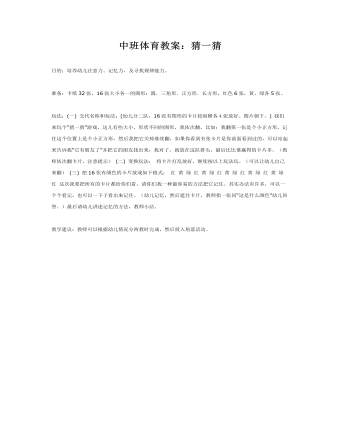
中班体育教案:猜一猜
玩法:(一) 交代名称和玩法:(幼儿分二队,16张有图形的卡片按纵横各4张放好。图片朝下。) 我们来玩个“猜一猜”游戏,这儿有些大小、形状不同的图形,我依次翻,比如:我翻第一张是个小正方形,记住这个位置上是个小正方形,然后我把它关掉继续翻,如果你看到有张卡片是你前面看到过的,可以站起来告诉我“它有朋友了”并把它的朋友找出来,找对了,就放在这队排头,最后比比谁赢得的卡片多。(教师依次翻卡片,注意提示)
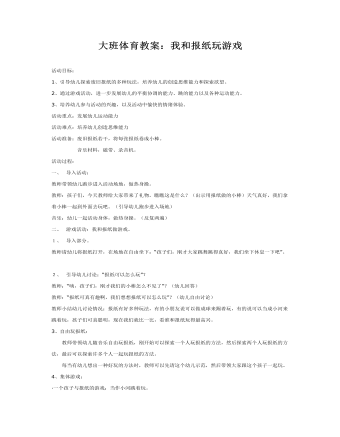
大班体育教案:我和报纸玩游戏
2、通过游戏活动,进一步发展幼儿的平衡协调的能力、跳的能力以及各种运动能力。3、培养幼儿参与活动的兴趣,以及活动中愉快的情绪体验。 活动重点:发展幼儿运动能力 活动难点:培养幼儿创造思维能力活动准备:废旧报纸若干,将每张报纸卷成小棒。 音乐材料,磁带、录音机。 活动过程: 一、 导入活动: 教师带领幼儿跑步进入活动场地,做热身操。 教师:孩子们,今天教师给大家带来了礼物。瞧瞧这是什么?(出示用报纸做的小棒)天气真好,我们拿着小棒一起到外面去玩吧。(引导幼儿跑步进入场地) 音乐:幼儿一起活动身体,做热身操。(反复两遍) 二、 游戏活动:我和报纸做游戏。 1、 导入部分。 教师请幼儿将报纸打开,在场地在自由坐下:“孩子们,刚才大家跳舞跳得真好,我们坐下休息一下吧”。 2、 引导幼儿讨论:“报纸可以怎么玩”? 教师:“咦,孩子们,刚才我们的小棒怎么不见了”?(幼儿回答) 教师:“报纸可真有趣啊,我们想想报纸可以怎么玩”?(幼儿自由讨论) 教师小结幼儿讨论情况:报纸有好多种玩法,有的小朋友说可以做成球来踢着玩,有的说可以当成小河来跳着玩,孩子们可真聪明,现在我们就比一比,看谁和报纸玩得最高兴。
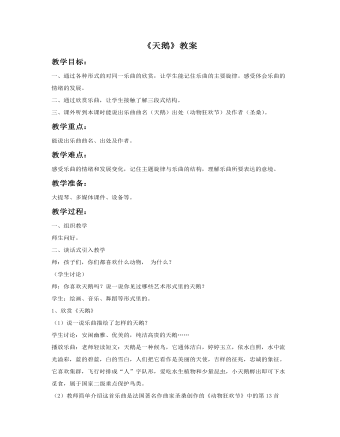
《天鹅》教案
一、组织教学师生问好。二、谈话式引入教学师:孩子们,你们都喜欢什么动物, 为什么?(学生讨论)师:你喜欢天鹅吗?说一说你见过哪些艺术形式里的天鹅?学生:绘画、音乐、舞蹈等形式里的。1、欣赏《天鹅》(1)说一说乐曲描绘了怎样的天鹅?学生讨论:安闲幽雅、优美的,纯洁高贵的天鹅……播放乐曲:老师轻读短文:天鹅是一种候鸟,它通体洁白,婷婷玉立,依水自照,水中流光溢彩,蓝的碧蓝,白的雪白,人们把它看作是美丽的天使,吉样的征兆,忠诚的象征。它喜欢集群,飞行时排成“人”字队形,爱吃水生植物和少量昆虫,小天鹅孵出即可下水觅食,属于国家二级重点保护鸟类。
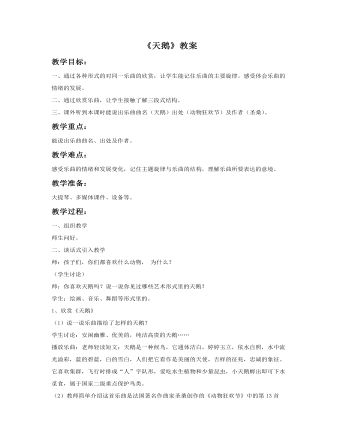
《天鹅》教案
一、组织教学师生问好。二、谈话式引入教学师:孩子们,你们都喜欢什么动物, 为什么?(学生讨论)师:你喜欢天鹅吗?说一说你见过哪些艺术形式里的天鹅?学生:绘画、音乐、舞蹈等形式里的。1、欣赏《天鹅》(1)说一说乐曲描绘了怎样的天鹅?学生讨论:安闲幽雅、优美的,纯洁高贵的天鹅……播放乐曲:老师轻读短文:天鹅是一种候鸟,它通体洁白,婷婷玉立,依水自照,水中流光溢彩,蓝的碧蓝,白的雪白,人们把它看作是美丽的天使,吉样的征兆,忠诚的象征。它喜欢集群,飞行时排成“人”字队形,爱吃水生植物和少量昆虫,小天鹅孵出即可下水觅食,属于国家二级重点保护鸟类。

《天鹅》教案
教学过程:一、组织教学1、师:孩子们,让我们随着音乐,模仿老师的动作进教室。(音乐《天鹅》伴奏。)2、师生问好。二、谈话式引入教学。孩子们,大家喜欢舞蹈吗?老师也特别喜欢,看看照片上的舞者,你们认为是模仿哪种小动物呢?1、边听边让学生仔细看看这是哪种小动物?2、让我们来模仿一下它的动作,师生共同学习。三、今天老师就将带着大家走进这神奇的童话世界,去欣赏由法国作曲家圣桑作曲的《天鹅》。1、请大家认真倾听,感受一下乐曲所要表现的情绪,并充分发挥你所想象力,为乐曲取一个好听的名字。多媒体播放《天鹅》教师轻声的配上讲述,帮助学生理解内容。2、让我们来看看乐曲的创作者为乐曲取了一个怎样的名字。请大家看大屏幕,出示课题《天鹅》。
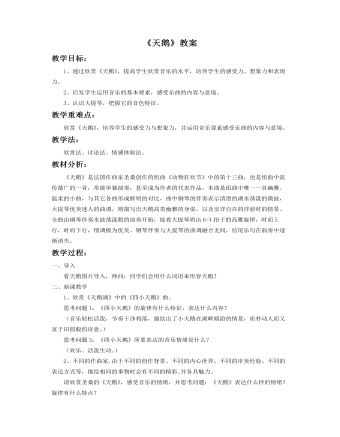
《天鹅》教案
教学目标: 1、通过欣赏《天鹅》,提高学生欣赏音乐的水平,培养学生的感受力、想象力和表现力。 2、启发学生运用音乐的基本要素,感受乐曲的内容与意境。 3、认识大提琴,把握它的音色特征。教学重难点: 欣赏《天鹅》,培养学生的感受力与想象力,并运用音乐要素感受乐曲的内容与意境。教材分析: 《天鹅》是法国作曲家圣桑创作的组曲《动物狂欢节》中的第十三曲,也是组曲中流传最广的一首,常被单独演奏,甚至成为作者的代表作品,本曲是组曲中唯一一首幽雅、温柔的小曲,与其它各曲形成鲜明的对比,曲中钢琴的伴奏表示清澄的湖水荡漾的微波,大提琴优美迷人的曲调,则描写出天鹅高贵幽雅的身姿,以及安详自在的浮游时的情景。全曲由钢琴伴奏水波荡漾般的前奏开始,接着大提琴唱出6/4拍子的高雅旋律,时而上行,时而下行,情调极为优美。钢琴伴奏与大提琴的曲调融合无间,结尾乐句在弱奏中逐渐消失。
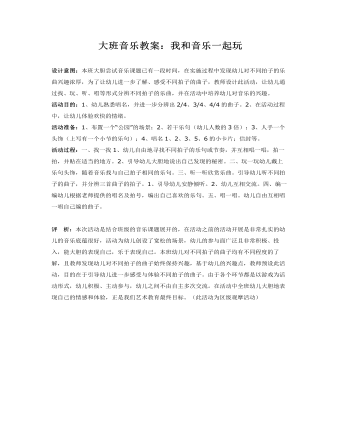
大班音乐教案:我和音乐一起玩
活动准备:1、布置一个“公园”的场景;2、若干乐句(幼儿人数的3倍);3、人手一个头饰(上写有一个小节的乐句);4、唱名1、2、3、5、6的小卡片;信封等。活动过程:一、找一找1、幼儿自由地寻找不同拍子的乐句或节奏,并互相唱一唱,拍一拍,并贴在适当的地方。2、引导幼儿大胆地说出自己发现的秘密。二、玩一玩幼儿戴上乐句头饰,随着音乐找与自己拍子相同的乐句。三、听一听欣赏乐曲。引导幼儿听不同拍子的曲子,并分辨三首曲子的拍子。1、引导幼儿安静倾听。2、幼儿互相交流。四、编一编幼儿根据老师提供的唱名及拍号,编出自己喜欢的乐句。五、唱一唱。幼儿自由互相唱一唱自己编的曲子。
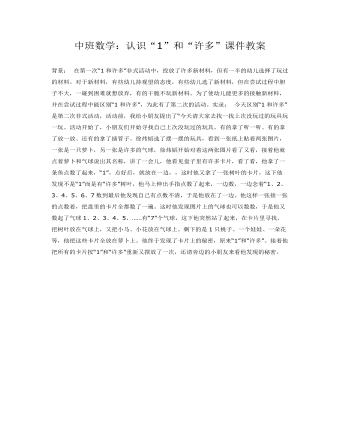
中班数学:认识“1”和“许多”课件教案
实录: 今天区别“1和许多”是第二次非式活动,活动前,我给小朋友提出了“今天请大家去找一找上次没玩过的玩具玩一玩。活动开始了,小朋友们开始寻找自己上次没玩过的玩具。有的拿了听一听、有的拿了放一放、还有的拿了插管子。徐炜韬选了摆一摆的玩具,看到一张纸上贴着两张图片,一张是一只萝卜,另一张是许多的气球,徐炜韬开始对着这两张图片看了又看,接着他就点着萝卜和气球说出其名称,讲了一会儿,他看见盘子里有许多卡片,看了看,他拿了一条鱼点数了起来,“1”,点好后,就放在一边,,这时他又拿了一张树叶的卡片,这下他发现不是“1”而是有“许多”树叶,他马上伸出手指点数了起来,一边数,一边念着“1、2、3、4、5、6、7数到最后他发现自己有点数不清,于是他放在了一边。
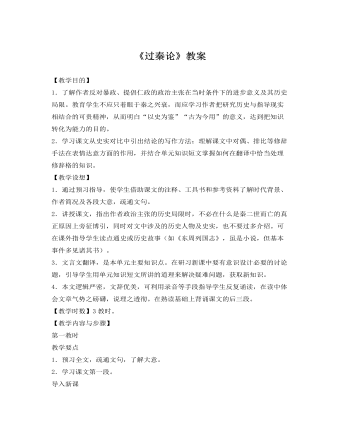
人教版高中语文《过秦论》教案
【教学目的】1.了解作者反对暴政、提倡仁政的政治主张在当时条件下的进步意义及其历史局限。教育学生不应只着眼于秦之兴衰,而应学习作者把研究历史与指导现实相结合的可贵精神,从而明白“以史为鉴”“古为今用”的意义,达到把知识转化为能力的目的。2.学习课文从史实对比中引出结论的写作方法;理解课文中对偶、排比等修辞手法在表情达意方面的作用,并结合单元知识短文掌握如何在翻译中恰当处理修辞格的知识。【教学设想】1.通过预习指导,使学生借助课文的注释、工具书和参考资料了解时代背景、作者简况及各段大意,疏通文句。2.讲授课文,指出作者政治主张的历史局限时,不必在什么是秦二世而亡的真正原因上旁征博引,同时对文中涉及的历史人物及史实,也不要过多介绍。可在课外指导学生读点通史或历史故事(如《东周列国志》,虽是小说,但基本事件多见诸其书)。
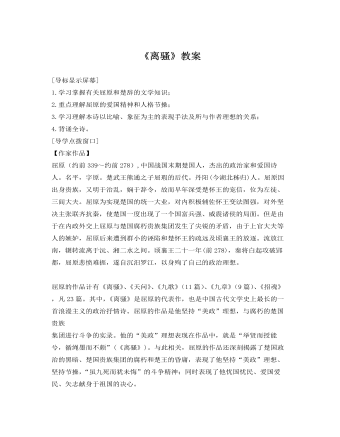
人教版高中语文《离骚》教案
2.亦余心之所善兮。虽九死其犹未悔评析:这一句表明屈原志向不改,坚贞不屈。真可说是一条铁骨铮铮的汉子。屈原最不能容忍的是那群无耻小人对他的恶毒诬蔑,一会说他穿着奇装异服,一会又说他面容姣好,肯定是个善淫之辈。这群人追名逐利,篡改法令,歪曲是非,混淆黑白,竞相谄媚,把朝廷弄得乌烟瘴气。屈原下决心绝对不和他们合流,他自比不合群的鸷鸟,孤傲、矫健,“自前世而固然”,他不想改变,也无法改变,这就像方圆不能周,异道不相安一样。在这里,屈原清楚地预感到了自己的结局,但他并不后悔自己的选择。句中“虽九死其犹未悔”和同出自于《离骚》的“路曼曼其修远兮,吾将上下而求索”诗句是后人引以自勉和共勉最多的句子。运用:(翻译)只要是我心中所向往喜欢的,即使死去九次也不会后悔。3.民生各有所乐兮,余独好修以为常。虽体解吾犹未变兮,岂余心之可惩。